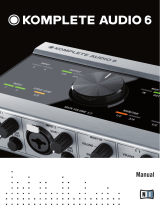
Warranty Information
M-AUDIO warrants this product, under normal use, to be free of defects in materials and workmanship
for a period of One (1) Year from date of purchase, so long as: the product is owned by the original
purchaser, with proof of purchase from an authorized M-AUDIO dealer and, the product has been
registered to the original purchaser, the purchaser having returned to M-AUDIO the completed product
warranty card.This warranty explicitly excludes power supplies and included cables which may become
defective as a result of normal wear and tear.
In the event that M-AUDIO receives, from an original purchaser and within the warranty coverage period,
written notice of defects in materials or workmanship, M-AUDIO will either replace the product, repair
the product, or refund the purchase price at its option. In the event repair is required, shipment to and
from M-AUDIO and possible nominal handling charges shall be born by the purchaser. In the event that
repair is required, a Return Authorization number must be obtained from M-AUDIO.After this number is
obtained, the unit should be shipped back to M-AUDIO in a protective package with a description of the
problem and the Return Authorization clearly written on the package.
In the event that M-AUDIO determines that the product requires repair because of user misuse or regular
wear, it will assess a fair repair or replacement fee.The customer will have the option to pay this fee and
have the unit repaired and returned, or not pay this fee and have the unit returned un-repaired.
The remedy for breach of this limited warranty shall not include any other damages. M-AUDIO will not
be liable for consequential, special, indirect, or similar damages or claims including loss of profit or any
other commercial damage, even if its agents have been advised of the possibility of such damages, and in
no event will M-AUDIO's liability for any damages to the purchaser or any other person exceed the price
paid for the product, regardless of any form of the claim. M-AUDIO specifically disclaims all other
warranties, expressed or implied. Specifically, M-AUDIO makes no warranty that the product is fit for any
particular purpose.This warranty shall be construed, interpreted, and governed by the laws of the state of
California. If any provision of this warranty is found void, invalid or unenforceable, it will not affect the
validity of the balance of the warranty, which shall remain valid and enforceable according to its terms. In
the event any remedy hereunder is determined to have failed of its essential purpose, all limitations of
liability and exclusion.
29
E
N
G
L
I
S
H
M-AUDIO U.S. M-AUDIO U.K.
45 E. Saint Joseph St. Unit 5, Saracen Industrial Estate
Arcadia, CA 91006-2861 Mark Rd.
U.S.A. Hemel Hempstead, Herts HP2 7BJ
England
Sales Information: 626-445-2842 Sales Information: 44 (0) 144 241 6590
Tech Support: 626-445-8495 Technical Support: 44 (0) 871 717 7102
Fax: 626-445-7564 Fax: 44 (0) 144 224 6832
Internet Home Page: http://www.m-audio.com Internet Home Page: http://www.maudio.co.uk
M-AUDIO Canada M-AUDIO France
1400 St-Jean Baptiste Ave., #150 Unit 5, Saracen Industrial Estate
Quebec City, QC G2E 5B7 Mark Rd.
Canada Hemel Hempstead, Herts HP2 7BJ
England
Tel: 418-872-0444 Sales Information: 0810 001 105
Fax: 44 (0) 144 224 6832
Internet Home Page: http://www.maudio.co.uk
M-AUDIO Deutschland (Germany) M-AUDIO Japan
Kuhallmand 34 Annex Buliding 6F
D-74613 Ohringen 2-18-10 Marunouchi
Germany Naka-Ku, Nagoya 460-0002
Japan
Sales Information:
49 7941 98 7000 Tel: 81 52 218 3375
Sales Information (email):
Fax:
81 52 218 0875
Technical Support: 49 7941 98 70030 Technical Support: 0820 00 731
T
28
E
N
G
L
I
S
H

















